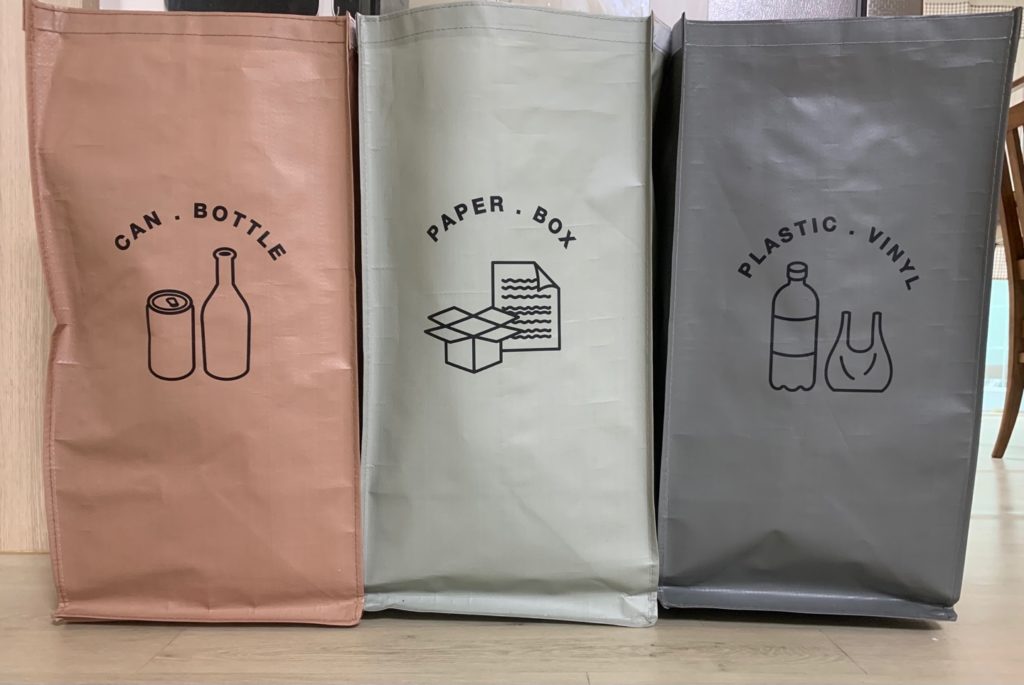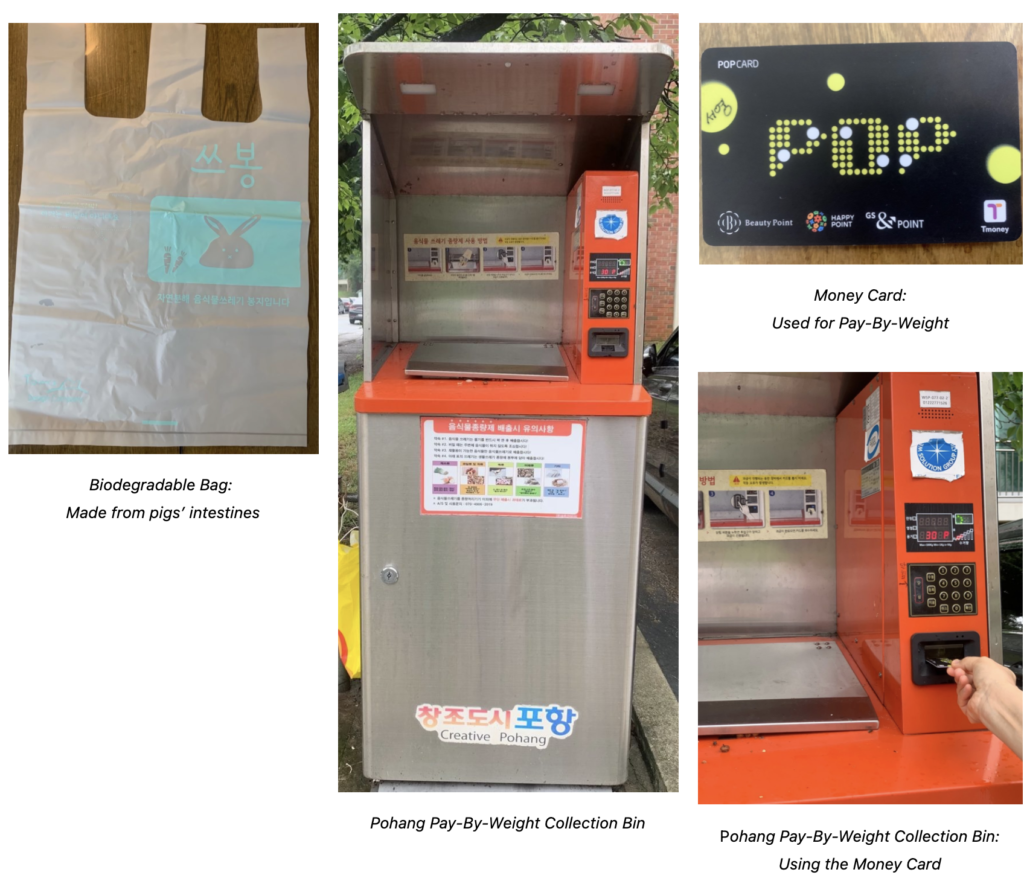For the past few years, South Korea has remained firmly in the top 5 for recycling and waste management systems with its recycling rate at about 50 percent. Their waste management system, known as jongnyangje (종량제), differentiates waste into categories of general waste, food waste, business waste, public purposes and construction debris. The mandatory nature of the system, combined with various efforts made by its Ministry of Environment, has allowed South Korea to rise in the ranks. The US, on the other hand, has never reached the top 10 for recycling rates with its current rate at about 34 percent; in fact, the US is one of the top 5 countries that produce the most waste as of 2021.
As someone who was born and raised in the US and has lived in several different states, I’m very familiar with the overall system of waste management in the US. However, as a Korean, I’ve visited and stayed in Korea for months at a time and seen for myself the radical difference in Korea’s waste management system versus America’s. I am actually currently visiting Korea at the moment, giving me a unique point of view on the topic of this article.
So, what about Korea’s waste management system makes it so different from the US?
Progression of South Korea’s Waste Management
South Korea’s most active efforts to combat the inefficiency and effectiveness of their waste disposal system began in the mid-1990’s. The country introduced a variety of strategies, such as the volume-based waste fee (VBWF) system and extended producer responsibility (EPR) scheme. The VBWF system served to reduce waste discharge and increase incorporation of recyclable materials; the EPR scheme helped encourage the recycling of packaging materials. Not only this, the incorporation of a waste-to-energy conversion system, installation of waste disposal facilities, anti-illegal dumping policies, and other programs put South Korea on the fast track towards zero waste.
The vital point of change for Korea in upgrading their systems was the establishment of a clear and attainable goal within a set time frame. Their goal was threefold: achieve a 71 percent recycling rate, reduce food waste by 30 percent and minimize landfill waste by 2020.
What is a VBWF System?
This volume-based waste fee is a core aspect of Korea’s waste management system (종량제) as it requires the separation of waste into several categories. The main objective of the VBWF system is twofold: impose waste treatment costs on each waste generator based on the amount of waste, and provide a free collection service for recyclable wastes.
Every household is required to discard its waste into prepaid standard garbage bags that vary in price according to volume and size, and also serve to fund Korea’s waste management service. In order to ensure citizens follow these systems, the law requires residents to sort out their waste accordingly, and refusal to comply with garbage disposal rules can incur fines of up to approximately $1,000 US dollars.
The Waste Management Act in South Korea states that local governments are primarily responsible for household waste (provinces and municipalities like cities, counties and districts). Every local government enforces the VBWF system differently and based on what kind of house you live in (apartment, single home, studio, etc.) there are varying systems in place for citizens to follow. Most general waste disposal is relatively uniform with the use of varying types of bags and/or color coding system that identifies things as general waste versus cans/bottles, paper/boxes or plastic/vinyl. Households are required to sort these things out at home before placing them in the according bags or apartment/house designated areas. Food waste, as we will discuss, has more variety in services.

Having to sort out your general waste, recyclables and food waste can seem like a headache, but there are many guides available as to what kinds of things are classified in each category.
Success of VBWF and Food Waste
The VBWF system has observed a notable amount of success, with a 17.8 percent reduction in municipal solid waste (MSW) generation and 21 percent increase in recyclable wastes in just the first year. Between 1994 and 2001, South Korea saw a decrease in MSW generation by 16.6 percent, and at the same time, an increase in the recycling rate from 15.7 per cent in 1994 to 43 per cent in 2001.
Food waste (음식물 쓰레기) was also a concerning issue with South Koreans observing a recycle rate of just 2 percent in 1995. South Koreans generate more than 130 kg of food waste per person each year. In comparison, according to the Food and Agricultural Organization of the United Nations, per capita food waste in Europe and North America is 95 to 115 kg per year. This alarmingly low food waste recycle rate in South Korea did not remain an issue for long, however.
In 2013, the country began implementing a compulsory food waste recycling program within the existing VBWF system, where households pay $6 per month for each biodegradable bag of wasted food thrown out. Korea also integrated technologies like smart bins that weigh residents’ food waste and charge them accordingly, which acts to fund Korea’s waste disposal services. According to officials, these efforts have helped to slash the amount of food waste in Seoul by 47,000 tonnes within six years, and raised Korea’s food waste recycling rate to 95 percent.
It is interesting to note that there may be slightly varying methods of dealing with food waste according to the area’s local government and the individual’s housing type. The biodegradable bags offered by area can differ in composition, collection can be pay-by-weight or covered within maintenance fees, etc. For example, my aunt who lives in an apartment complex in urban Pohang has biodegradable bags made from natural material like pigs’ intestines and has a pay-by-weight collection bin. Her area even offers money cards (similar to subway cards) that are used solely for these pay-by-weight bins.

Incorporation into US Systems
How can all of this help the US decrease its ecological footprint in terms of waste pollution? At the moment, America’s National Recycling Goal is to increase the national recycling rate to 50 percent by 2030. However, while the US does implement waste-to-energy conversion systems such as incineration and anaerobic digestion in municipal facilities, its view of waste management remains far too broad and loose. Much of the system is based in quantitative risk assessment, risk-based decision-making and landfill disposal, as opposed to more environmentally friendly and individually-focused waste disposal techniques.
As has been observed in Korea and many other top ranked countries, a focus on the citizens—individual waste generators—is just as important as policing large and corporate waste generators. In order for the US to see significant improvement in waste disposal/recycling rates, it must be proactive in implementing all-encompassing and mandatory systems such as those of South Korea and other environmentally-focused countries. If the US’s current waste disposal systems were to continue, notable improvement in recycling and waste disposal rates should not be expected. However, with the adoption of an open-minded attitude for action and change, the US can without a doubt reach its recycling goals and become a country that stands for necessary environmentalism—even if it inconveniences the people.
- How Does Globalization Affect Income Inequality in the US? - September 27, 2021
- How a Decline in Unions Contributes to Income Inequality - September 23, 2021
- The Big Three: Exploring Wage Gaps in the US - September 13, 2021

High from Montréal
Very interesting approach. My question is related to fiscal measures taken in South Korea to improve tax compliance in waste management collection
Thank you